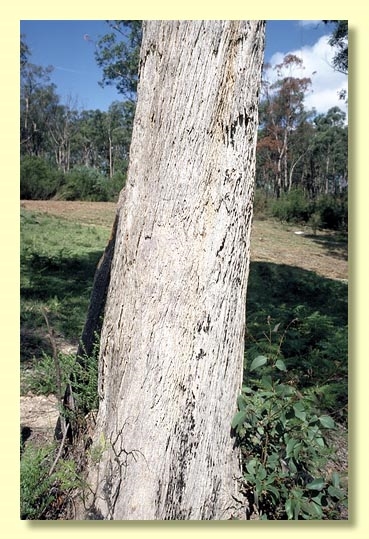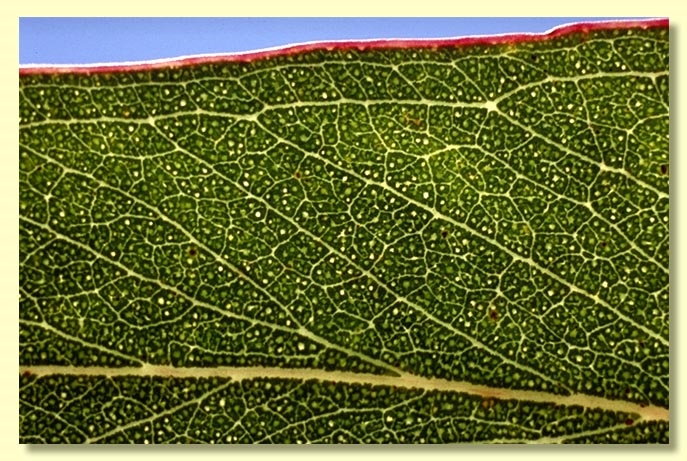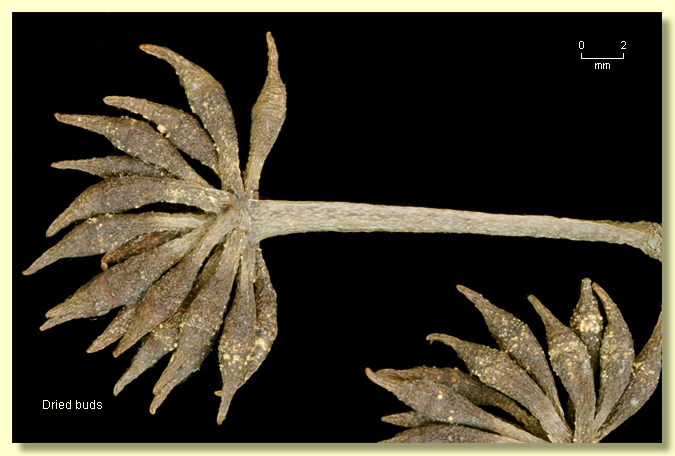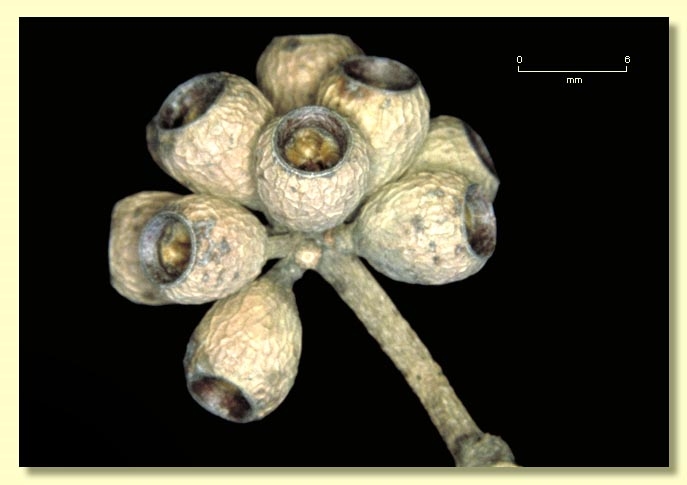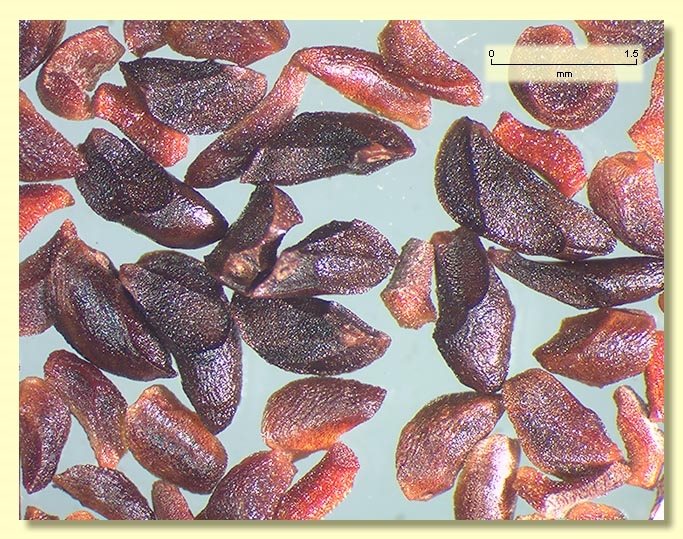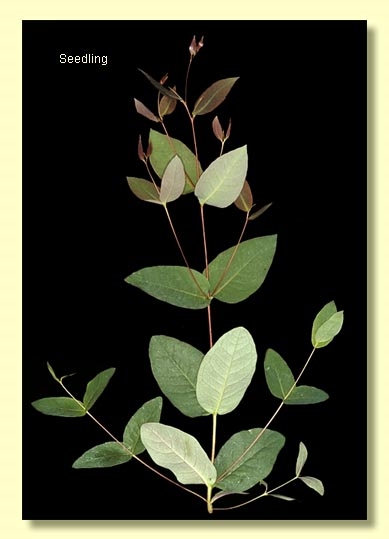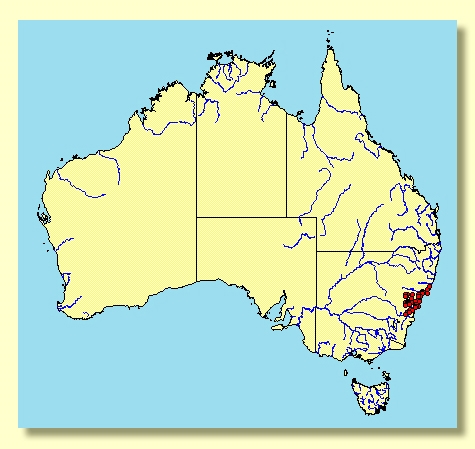Euclid - Online edition
Eucalyptus piperita subsp. piperita
Classification
Eucalyptus | Eucalyptus | Cineraceae | Piperitales
Nomenclature
Eucalyptus piperita Sm. in J.White, J. Voy. New South Wales 226 (1790) subsp. piperita.
T: Port Jackson, NSW, J.White s.n.; holo: LINN; iso: BM, G.
Metrosideros aromatica Salisb., Prodr. 351 (1796); E. aromatica (Salisb.) Domin, Biblioth. Bot. 89: 461 (1928). T: Port Jackson, NSW, D.Burton; herbarium of cited specimen not known to us.
Eucalyptus piperita var. laxiflora Benth., Fl. Austral. 3: 207 (1867). T: Manly Beach, NSW, W.Woolls s.n.; syn: K, MEL ; Camden, NSW, J.Backhouse s.n.; syn; Macleay R., NSW, H.Beckler; syn; Clarence R., NSW, H.Beckler s.n.; syn: MEL.
Eucalyptus bottii Blakely, J. & Proc. Roy. Soc. New South Wales 61: 163 (1927), fide L.D.Pryor & L.A.S.Johnson, Class. Eucalypts 61 (1971). T: between Stanwell Park and Otford, NSW, W.F.Blakely s.n.; holo: NSW.
T: Port Jackson, NSW, J.White s.n.; holo: LINN; iso: BM, G.
Metrosideros aromatica Salisb., Prodr. 351 (1796); E. aromatica (Salisb.) Domin, Biblioth. Bot. 89: 461 (1928). T: Port Jackson, NSW, D.Burton; herbarium of cited specimen not known to us.
Eucalyptus piperita var. laxiflora Benth., Fl. Austral. 3: 207 (1867). T: Manly Beach, NSW, W.Woolls s.n.; syn: K, MEL ; Camden, NSW, J.Backhouse s.n.; syn; Macleay R., NSW, H.Beckler; syn; Clarence R., NSW, H.Beckler s.n.; syn: MEL.
Eucalyptus bottii Blakely, J. & Proc. Roy. Soc. New South Wales 61: 163 (1927), fide L.D.Pryor & L.A.S.Johnson, Class. Eucalypts 61 (1971). T: between Stanwell Park and Otford, NSW, W.F.Blakely s.n.; holo: NSW.
Description
Tree to 20 m tall. Forming a lignotuber.
Bark rough on trunk and larger limbs, finely fibrous or peppermint-type, grey or grey-brown; limbs usually smooth, white to cream or grey, often powdery.
Juvenile growth (coppice or field seedlings to 50 cm): stem rounded in cross-section, sometimes warty; juvenile leaves opposite, sessile to subsessile and amplexicaul for ca 5 to 7 nodes then alternate, petiolate, ovate to elliptical, 4.3–12.5 cm long, 1.8–6.5 cm wide, base truncate or tapering to petiole, tending to oblique, discolorous, dull, blue-green.
Adult leaves alternate, petiole 1.2–2.7 cm long; blade lanceolate to falcate, 7–16 cm long, 1.2–3.5 cm wide, base oblique or tapering to petiole, concolorous, dull, green to blue-green, side-veins at an acute or wider angle to midrib, moderately to densely reticulate, intramarginal vein parallel to and remote from margin (sometimes doubled), oil glands island or obscure.
Inflorescence axillary unbranched, peduncles 0.8–2.5 cm long, buds 9 to ?15 per umbel, pedicels 0.2–0.6 cm long. Mature buds fusiform, 0.5–0.7 cm long, 0.2–0.3 cm wide, scar absent, operculum conical to beaked, stamens irregularly flexed, all fertile, anthers reniform to cordate, versatile, dorsifixed, dehiscing by confluent slits, style long, stigma tapered, locules (3)4, the placentae each with 2 vertical ovule rows. Flowers white.
Fruit sessile or on pedicels to 0.5 cm long, barrel-shaped, 0.5–0.8 cm long, 0.4–0.7 cm wide, disc descending, valves (3)4, enclosed.
Seeds dark brown to grey or black, 1.5–2.5 mm long, pyramidal or obliquely pyramidal, dorsal surface usually smooth, hilum terminal.
Cultivated seedlings (measured at ca node 10): cotyledons reniform; stems rounded in cross-section; leaves sessile, opposite, broadly ovate with amplexicaul bases for 5 to 7 nodes, then becoming alternate, shortly petiolate, ovate, 6–10 cm long, 2.2–5 cm wide, base rounded to tapering then oblique, margin entire, apex pointed, discolorous, dull, green.
Bark rough on trunk and larger limbs, finely fibrous or peppermint-type, grey or grey-brown; limbs usually smooth, white to cream or grey, often powdery.
Juvenile growth (coppice or field seedlings to 50 cm): stem rounded in cross-section, sometimes warty; juvenile leaves opposite, sessile to subsessile and amplexicaul for ca 5 to 7 nodes then alternate, petiolate, ovate to elliptical, 4.3–12.5 cm long, 1.8–6.5 cm wide, base truncate or tapering to petiole, tending to oblique, discolorous, dull, blue-green.
Adult leaves alternate, petiole 1.2–2.7 cm long; blade lanceolate to falcate, 7–16 cm long, 1.2–3.5 cm wide, base oblique or tapering to petiole, concolorous, dull, green to blue-green, side-veins at an acute or wider angle to midrib, moderately to densely reticulate, intramarginal vein parallel to and remote from margin (sometimes doubled), oil glands island or obscure.
Inflorescence axillary unbranched, peduncles 0.8–2.5 cm long, buds 9 to ?15 per umbel, pedicels 0.2–0.6 cm long. Mature buds fusiform, 0.5–0.7 cm long, 0.2–0.3 cm wide, scar absent, operculum conical to beaked, stamens irregularly flexed, all fertile, anthers reniform to cordate, versatile, dorsifixed, dehiscing by confluent slits, style long, stigma tapered, locules (3)4, the placentae each with 2 vertical ovule rows. Flowers white.
Fruit sessile or on pedicels to 0.5 cm long, barrel-shaped, 0.5–0.8 cm long, 0.4–0.7 cm wide, disc descending, valves (3)4, enclosed.
Seeds dark brown to grey or black, 1.5–2.5 mm long, pyramidal or obliquely pyramidal, dorsal surface usually smooth, hilum terminal.
Cultivated seedlings (measured at ca node 10): cotyledons reniform; stems rounded in cross-section; leaves sessile, opposite, broadly ovate with amplexicaul bases for 5 to 7 nodes, then becoming alternate, shortly petiolate, ovate, 6–10 cm long, 2.2–5 cm wide, base rounded to tapering then oblique, margin entire, apex pointed, discolorous, dull, green.
Flowering Time
Flowering has been recorded in April, May and December.
Notes
Eucalyptus piperita is a small to medium-sized forest tree species of coastal plains, ranges and the eastern side of the tablelands of New South Wales from the Batemans Bay area of the South Coast north to Nabiac south of Taree. E. piperita is not closely related to any other species and the common name, Sydney Peppermint, is somewhat misleading as it is not a peppermint in the traditionally accepted sense. It has rough bark over the whole trunk but not the branches. The juvenile leaves resemble those of ashes in being soon alternate, petiolate, pendulous, broadly ovate. Adult leaves are relatively broad, dull, with moderate reticulation, buds are in > sevens, fusiform, often curved, opercula very acute.
There are two subspecies:
E. piperita subsp. piperita
Occurs northward from the Central Tablelands of New South Wales. Subsp. piperita is characterised by barrel-shaped fruit.
E. piperita subsp. urceolaris
Occurs south from the Central Tablelands of New South Wales. Subsp. urceolaris is characterised by the urceolate fruit.
The distinction between the two subspecies is often unclear.
Eucalyptus piperita belongs in Eucalyptus subgenus Eucalyptus section Cineraceae having the following characters: cotyledons reniform, juvenile leaves alternate, bluish, adult leaves with side-veins more or less acute, single axillary inflorescences with buds in clusters of nine to ?15, buds with single operculum, stamens with reniform anthers, ovules in two rows, and seeds more or less pyramidal. Within section Cineraceae, E. piperita is somewhat isolated (series Piperitales) by the combination of finely fibrous rough bark, stamens irregularly flexed and all fertile, and style long. E. piperita is easily distinguished from other finely fibrous rough-barked trees within its area of distribution by the glabrous alternate petiolate juvenile leaves, fusiform buds and fruit with descending disc.
There are two subspecies:
E. piperita subsp. piperita
Occurs northward from the Central Tablelands of New South Wales. Subsp. piperita is characterised by barrel-shaped fruit.
E. piperita subsp. urceolaris
Occurs south from the Central Tablelands of New South Wales. Subsp. urceolaris is characterised by the urceolate fruit.
The distinction between the two subspecies is often unclear.
Eucalyptus piperita belongs in Eucalyptus subgenus Eucalyptus section Cineraceae having the following characters: cotyledons reniform, juvenile leaves alternate, bluish, adult leaves with side-veins more or less acute, single axillary inflorescences with buds in clusters of nine to ?15, buds with single operculum, stamens with reniform anthers, ovules in two rows, and seeds more or less pyramidal. Within section Cineraceae, E. piperita is somewhat isolated (series Piperitales) by the combination of finely fibrous rough bark, stamens irregularly flexed and all fertile, and style long. E. piperita is easily distinguished from other finely fibrous rough-barked trees within its area of distribution by the glabrous alternate petiolate juvenile leaves, fusiform buds and fruit with descending disc.
Origin of Name
Eucalyptus piperita: Latin piperitus, pepper-like, probably referring to the essential oils as the original description refers to the peppermint smell.
Copyright © CANBR 2020, all rights reserved.

Web edition hosted at https://apps.lucidcentral.org/euclid
